
ActiveFloor + Attendance Recovery: A Powerful Path for Expanded Learning in California
California schools face an ongoing challenge: how to engage students meaningfully while also addressing lost instructional time caused by chronic absenteeism or emergencies. With the launch of the Attendance Recovery (AR) program, districts now have a new way to recoup state funding while giving students engaging opportunities to succeed.
At Technology in Education (TIE), we believe ActiveFloor is the perfect tool to meet this moment.
What is Attendance Recovery?
The California Department of Education’s Attendance Recovery program (established under Senate Bill 153 and SB 176) allows schools and districts to regain funding tied to student absences.
-
Students can make up missed instructional time by attending supplementary sessions outside the regular school day—before or after school, weekends, or during intersession breaks.
-
Districts can claim apportionment for up to 10 days of absences per student, per year, provided the sessions meet program requirements.
-
Instruction must be aligned to grade-level standards and supervised by certificated teachers.
This program gives local educational agencies (LEAs) an excellent opportunity to recover lost ADA (Average Daily Attendance) funding while re-engaging students academically.
Why ActiveFloor is a Perfect Fit
ActiveFloor is an interactive learning platform that combines physical activity with academic instruction. Students use a large, floor-based touch-sensitive projection to play games, solve problems, and engage in collaborative learning.
For grades K–6, ActiveFloor provides:
-
Standards-aligned instructional activities in math, literacy, and STEAM.
-
High engagement through movement-based, gamified lessons.
-
Expanded Learning opportunities that blend seamlessly into afterschool or weekend sessions.
Because Attendance Recovery requires in-person instruction that is substantially equivalent to the student’s regular instructional program, ActiveFloor is an ideal solution. It ensures students are learning, moving, and engaged—all while satisfying state requirements for attendance recovery.
Funding ActiveFloor Through Attendance Recovery
Here’s where the opportunity gets even stronger:
-
Schools or districts can recoup ADA funding through AR participation.
Each student who makes up an absence in an AR program translates into restored funding. -
Recovered funds can offset the cost of ActiveFloor.
By implementing ActiveFloor in expanded learning programs, schools can justify the investment as an attendance recovery strategy that pays for itself. -
Dual benefits with Expanded Learning Opportunity Program (ELO-P).
AR and ELO-P can run in conjunction, meaning districts can maximize resources while improving student outcomes.
In other words: ActiveFloor not only delivers student engagement and academic progress, it also helps districts access new revenue streams to cover the cost.
A Practical Example
Imagine a district with 1,000 elementary students. If 20% of them participate in just five AR sessions throughout the year, that could mean hundreds of days of attendance recovered—translating into tens of thousands of dollars in restored funding.
With that revenue, a district could fully implement ActiveFloor in its expanded learning programs, creating a sustainable model where the tool effectively funds itself.
The Takeaway
Attendance Recovery is more than a compliance measure—it’s an opportunity. By integrating ActiveFloor into expanded learning, California schools can:
-
Recover funding from lost attendance.
-
Provide engaging, activity-based instruction that students love.
-
Create sustainable, long-term investments in innovative learning tools.
At Technology in Education, we’re committed to helping districts design AR and ELO-P programs that both enrich student learning and maximize fiscal efficiency.
👉 If your district is exploring Attendance Recovery, let’s talk about how ActiveFloor can make it a win-win for both students and schools.


